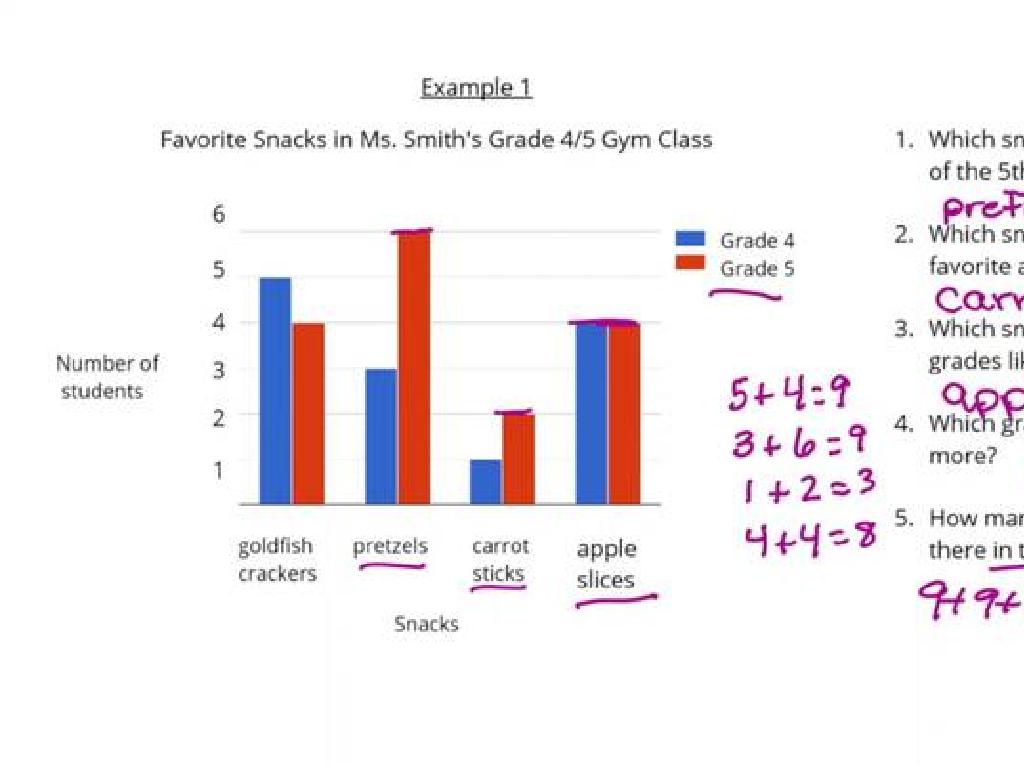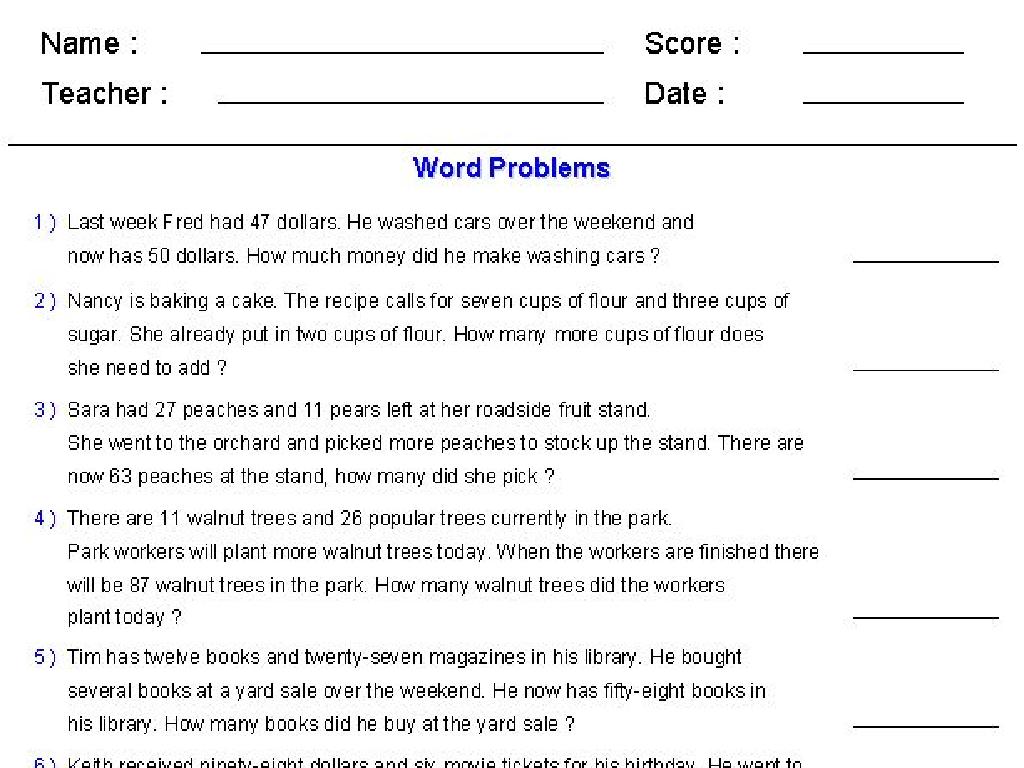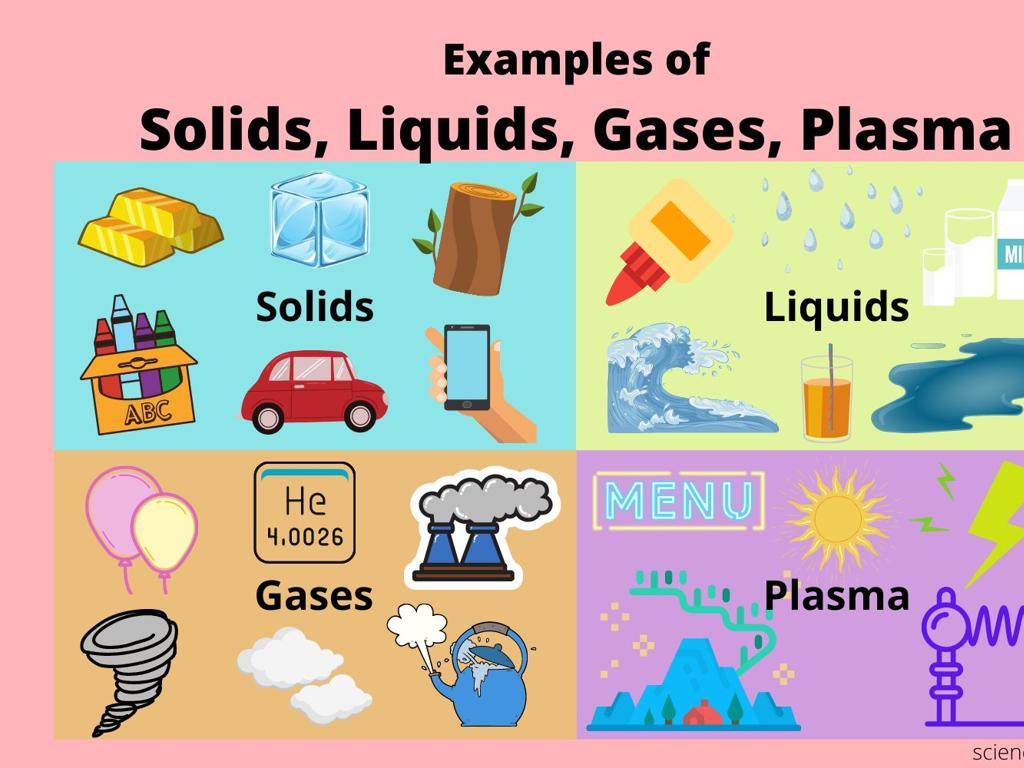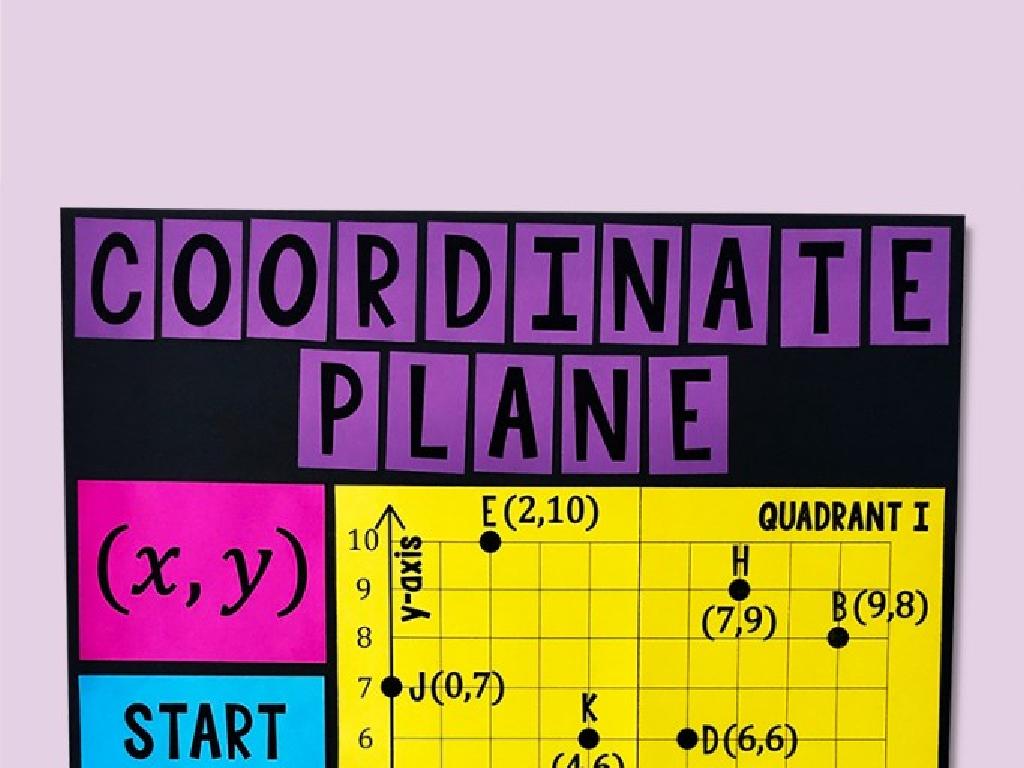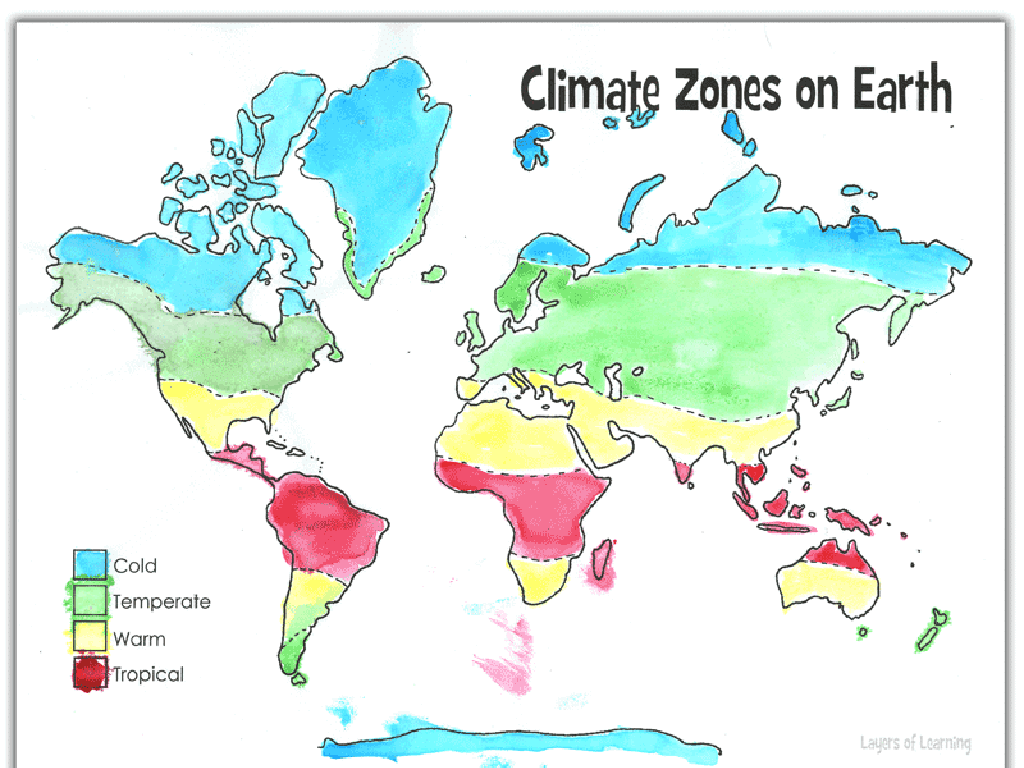Addition Word Problems - Three Numbers Up To Two Digits Each
Subject: Math
Grade: Second grade
Topic: Addition: Two Digits
Please LOG IN to download the presentation. Access is available to registered users only.
View More Content
Welcome to Addition Adventures!
– Becoming addition experts today
– Learn to add three numbers
– Add numbers like 15, 23, and 7 together
– Solve fun word problems
– Use stories to find sums, like apples in baskets
– Numbers up to two digits
– Practice with numbers like 34 + 21 + 10
|
This slide introduces the concept of adding three numbers, each up to two digits, through engaging word problems. Start by explaining that being an addition expert means being able to combine numbers quickly and accurately. Demonstrate how to add three numbers step by step, possibly using a number line or stacking method. Introduce word problems as stories that require addition to solve, making the activity relatable and fun. Provide examples with clear, simple numbers to ensure understanding. Encourage students to visualize the problems with real-life objects like fruits or toys to make the concept more tangible. The goal is to build confidence and excitement about addition.
Understanding Addition
– Addition: Combining numbers
– It’s finding the total, like 2 + 3 = 5
– Imagine adding apples together
– If you have 3 apples and get 2 more, now you have 5 apples!
– Adding makes groups bigger
– Like 3 toys plus 4 toys makes 7 toys
– Practice with real examples
|
This slide introduces the concept of addition to second-grade students by relating it to everyday experiences, such as gathering apples. Explain that addition is simply the process of combining two or more numbers to find out how many there are in total. Use tangible examples like apples or toys to illustrate the point. Encourage students to think of addition as making a bigger group out of smaller groups. Provide real-life scenarios where they can apply addition, such as combining sets of crayons or counting total fingers on both hands. The goal is to make them comfortable with the idea of addition before moving on to word problems.
Adding Three Numbers Together
– Add numbers in any order
– Example: 7 + 5 + 3
– Practice problem to solve together
– First add 7 and 5
– 7 plus 5 equals 12
– Then add 3 to the sum
– 12 plus 3 equals 15
|
This slide introduces the commutative property of addition, which states that numbers can be added in any order and the result will be the same. Start by explaining the concept with simple examples. Then, work through the example problem (7 + 5 + 3) as a class, demonstrating how to add the first two numbers and then add the third number to the sum. Emphasize that they can choose any two numbers to add first. Encourage students to practice with different combinations of numbers to see that the sum remains unchanged. This will help build their confidence in solving addition problems and understanding the flexibility of number order in addition.
Understanding Addition Word Problems
– Word problems are number stories
– Read carefully to find numbers to add
– Find the numbers in the story that need to be added together
– Look for clues and keywords for addition
– Words like ‘total’, ‘sum’, ‘together’, ‘plus’ indicate addition
– Practice with example problems
– Use example: If you have 23 apples, 15 oranges, and 10 bananas, how many fruits do you have in total?
|
This slide introduces students to the concept of addition word problems. Emphasize that word problems are like stories that involve numbers, and we need to read them carefully to solve the math puzzle. Encourage students to look for specific clues or keywords that signal addition, such as ‘total’, ‘sum’, ‘together’, and ‘plus’. Provide clear examples and guide them through the process of identifying the relevant numbers and performing the addition. For the activity, students can work on example problems and share their solutions. The teacher should prepare several examples of varying difficulty to cater to different skill levels within the class.
Adding Three Numbers: Word Problems
– Start with Sarah’s 12 apples
– Add the 15 apples from Tom
– Include the 8 apples from Mom
– Find the total number of apples
– Add all three amounts: 12 + 15 + 8
|
This slide introduces students to addition word problems involving three addends, each with up to two digits. The example provided uses a relatable scenario involving Sarah and apples to contextualize the problem. The slide breaks down the problem step by step, starting with the initial number of apples Sarah has, then sequentially adding the number of apples given by Tom and her mom. The final step is to combine all three numbers to find the total. In the notes, provide guidance on how to approach similar problems, emphasizing the importance of adding numbers in sequence and checking work for accuracy. Encourage students to visualize the problem with actual objects or drawings to aid their understanding. This hands-on approach can be particularly effective for second graders as it helps to solidify the concept of addition in a tangible way.
Let’s Practice Addition Together!
– Step-by-step problem solving
– I’ll guide you through an addition problem
– Identify keywords and numbers
– Look for ‘in all’, ‘together’, ‘sum’ to find numbers to add
– Mistakes help us learn
– It’s okay to get it wrong before you get it right
– Practice makes perfect
|
This slide is designed to engage students in a collaborative problem-solving activity. Start by presenting an addition word problem involving three numbers, each up to two digits. Walk the students through the problem-solving process, emphasizing the importance of identifying keywords that indicate addition, such as ‘in all’, ‘together’, or ‘sum’. Encourage students to participate by asking them what the next step is and to help find the numbers in the problem. Remind them that making mistakes is a natural part of learning and that each mistake is an opportunity to improve. Provide positive reinforcement and ensure a supportive atmosphere where students feel comfortable trying. End the activity by highlighting the value of practice in mastering addition word problems.
Your Turn to Try: Addition Word Problems
– Solve this word problem
– Add three two-digit numbers from the problem
– Use learned strategies for the sum
– Remember to line up the numbers by place value
– Share your answer with the class
– Explain how you found the sum when you’re done
– Feel proud of your math skills!
|
This slide is an interactive activity for students to apply their addition skills with a word problem involving three two-digit numbers. Encourage them to use strategies such as lining up numbers by place value and adding one column at a time. Remind them to check their work. After solving the problem, students should be ready to share their solution process and answer with the class, fostering a collaborative learning environment. As a teacher, prepare to guide students who may struggle and offer praise to build confidence. Possible activities: 1) Pair students to solve together, 2) Use manipulatives to visualize, 3) Create a game where correct answers earn points, 4) Have students write their own word problems, 5) Use a timer for a fun speed challenge.
Class Activity: Addition Relay Race
– Teams solve addition problems
– Each member adds one number
– Pass your sum to the next person
– First team with correct total wins!
|
This activity is designed to encourage teamwork and improve addition skills. Divide the class into small groups, each group will work as a team to solve an addition problem with three numbers, each up to two digits. One child from each team starts by adding the first two numbers, then passes their sum to the next team member, who adds the third number. The process continues until the last member of the team comes up with the total sum. The first team to arrive at the correct total and write it down wins the relay. Make sure to prepare different sets of numbers for each team to prevent copying and encourage fair play. Possible variations of the activity could include using dice to generate random numbers for addition, incorporating a physical relay element where students run to a designated spot to pass on their sum, or using a timer to add a time challenge aspect to the activity.
Conclusion & Homework: Addition Stars!
– Celebrate your hard work today
– Complete the worksheet for homework
– Solve the word problems using three numbers up to two digits each
– Practice makes perfect
– Keep practicing at home!
– Try creating your own addition problems too
|
Well done on today’s lesson on addition word problems involving three numbers with up to two digits each. As homework, students are to complete the provided worksheet which will reinforce the concepts learned in class. Encourage them to practice regularly as this will help solidify their understanding and improve their skills. Additionally, suggest that they try to create their own word problems, which can be a fun way to apply what they’ve learned. During the next class, we can review the homework and discuss any challenges the students faced.

